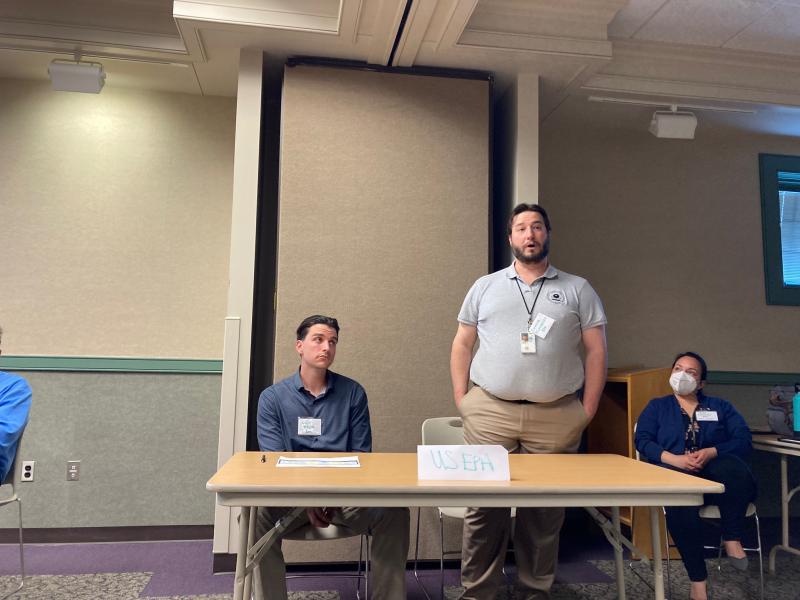EPA presents plans for Georgetown Superfund site

The U.S. Environmental Protection Agency presented plans April 20 to designate a .27-mile area in north Georgetown as a Superfund site.
The EPA is proposing to call the site the Georgetown North Groundwater Site and put the area under the Superfund National Priorities List, which would provide funding and jump-start the cleanup process of contamination of perchloroethylene and trichloroethylene in the groundwater, exposure to which has been linked to cancers and birth defects.
The EPA says Georgetown’s drinking water is currently treated to remove contamination from PCE and TCE, and the town’s water meets state and federal drinking water standards.
The proposed area runs north to south starting from North Railroad Avenue to just before East Market Street (Route 9), and east to west from Broad Alley to just before North Bedford Street. The area included the former Thoro-Kleen dry cleaners on North Railroad Avenue and the former Georgetown Dry Cleaners on North Race Street. The Town of Georgetown has seven public wells in that area.
PCE and TCE were commonly used in dry cleaning operations and metal degreasing. Neither dry cleaner is still in business; Thoro-Kleen ceased operations in 2010, and Georgetown Dry Cleaners ceased operations in the late 1990s. Three other dry cleaners are in the area, but the EPA did not find contamination at those sites.
In 2018, Delaware Department of Natural Resources and Environmental Control requested the EPA’s assistance in sampling the sites, and it conducted site inspections in 2020. In March, the EPA proposed adding the site to the Superfund National Priorities List.
At the April 20 presentation, EPA and other state and federal officials took questions on the proposal from the public.
When asked whether there would be studies conducted to monitor the health of people in the affected area, Karl Markiewicz of the Agency for Toxic Substances and Disease Registry said the most likely path forward is to do a public health assessment to look at past, current and future exposures, as well as the rate of diseases such as cancer.
EPA officials Dan Taylor and Connor O’Loughlin were asked whether PCE and TCE are still used by dry cleaners. O’Loughlin said they are, but the use of the products is being phased out, and there are more regulations in place to prevent environmental problems like those at the two Georgetown sites. When pressed on why it would still be allowed even if it’s a known carcinogen, Markiewicz said the difference is the quantity, concentration and how long someone is exposed.
“It takes many years of exposure in a high enough concentration to result in those kinds of cancers,” he said.
The time frame for anything to happen will be years into the future, however. Once the site is listed as a Superfund site, which would happen by fall if it is accepted by the public, EPA would start a remedial investigation. The end goal of the investigation is to create a feasibility study, documenting the potential alternatives for cleaning up the site. At the end of that, the EPA will issue a record of decision on the preferred alternative.
At that point, design work will begin, Taylor said. EPA plans to involve the public in the process, he said.
How long it takes to actually clean up the site depends on how long the investigative and design work take. Sites can take as little as six to eight years or as long as 30 to 40 years, depending on the severity of the environmental damage and what is needed to clean it up.
How long it takes to actually cleanup the site depends on how long the investigative and design work takes. Sites can take as little as six to eight years or as long as 30 to 40 years, depending on the severity of the environmental damage and what is needed to clean it up.
Public comment on the proposal runs through Tuesday, May 17, and can be submitted online at regulations.gov under EPA-HQ-OLEM-2022-0190 or by mail to U.S. Environmental Protection Agency, EPA Docket Center, Docket # EPA-HQ-OLEM-2022-0190, Mailcode 28221T, 1200 Pennsylvania Ave. NW, Washington, DC 20460. More information about the proposal can be found at epa.gov/superfund/georgetowngroundwater.
Ryan Mavity covers Milton and the court system. He is married to Rachel Swick Mavity and has two kids, Alex and Jane. Ryan started with the Cape Gazette all the way back in February 2007, previously covering the City of Rehoboth Beach. A native of Easton, Md. and graduate of Towson University, Ryan enjoys watching the Baltimore Ravens, Washington Capitals and Baltimore Orioles in his spare time.




















































